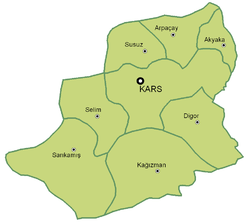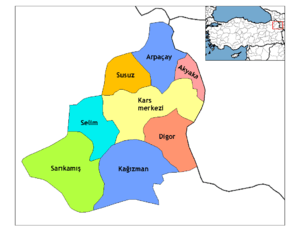Kars Province
Kars Province (Turkish: Kars ili, Kurdish: Parêzgeha Qersê,[3] Armenian: Կարսի նահանգ[4]) is a province of Turkey, located in the northeastern part of the country. It shares part of its closed border with Armenia. The provincial capital is the city of Kars. The provinces of Ardahan and Iğdır were until the 1990s part of Kars Province.
Kars Province Kars ili | |
|---|---|
 Kars Province Subdivisions | |
 Location of Kars Province in Turkey | |
| Country | Turkey |
| Region | Northeast Anatolia |
| Subregion | Ağrı |
| Government | |
| • Electoral district | Kars |
| • Governor | Eyüp Tepe[1] |
| Area | |
| • Total | 9,587 km2 (3,702 sq mi) |
| Population (2018)[2] | |
| • Total | 288,878 |
| • Density | 30/km2 (78/sq mi) |
| Area code(s) | 0474 |
| Vehicle registration | 36 |
History
In ancient times, Kars (Armenian:Կարս) was part of the province of Ararat in the Kingdom of Armenia. The first known people were the followers of Vanand (Վանանդ), for whom Kars was their main settlement and fortress. In 928, Kars became the capital of Bagratid Armenia. In 968, the capital of Armenia was moved to Ani, but Kars remained the capital of the feudal principality of Vanand.
The Seljuks quickly relinquished direct control over Kars and it became a small emirate whose territory corresponded closely to that of Vanand, and which bordered the similarly created but larger Shaddadid emirate centered at Ani. The Kars emirate was a vassal of the Saltukids in Erzurum, whose forces were effective in opposing Georgian attempts at seizing Kars. Later on, in 1207, Georgian army commanded by David Soslan and brothers Ivane and Zakare Mkhargrzeli captured Kars after a long siege. George IV son of Tamar, was appointed as a viceroy of Kars. It was conquered in 1242 by the Mongols; was regained by Georgian Kingdom during the reign of George V the Brilliant (1314–1346) and remained as part of the Kingdom before its disintegration, which then passed into the hands of Georgian Atabegs belonging to the House of Jaqeli. During the rule of the Persian Empire and the Ottoman Empire, the fortress of Kars, located in what was then the eastern part of the city, fell into disrepair. However, as Kars was within a border region its defensive structures were often renewed, and they continued to advance to such a degree, that in the 19th century Kars was well known around the world as a castle.
As a result of the Russo-Turkish War of 1877 to 1878, the province of Kars was incorporated into the Russian Empire as part of the militarily administered Kars Oblast and remained so until 1918. It was seen as a border province of a Russian Empire which was seeking to expand yet further by the conquest of more territory belonging to the Ottoman Empire.[5] The period from 1878 to 1918 was marked in the province of Kars by the settlement by the Russian authorities of a very heterogeneous mix of Christian populations, including Armenians, Caucasus Greeks, Russians, Georgians, and even smaller numbers from other Christian communities hitherto with little or no historical links to the region, such as ethnic Germans, Poles, Estonians, Lithuanians, and Russian sectarian communities such as Molokans and Doukhobors. Many from the non-Russian Christian Orthodox communities (Georgians, Caucasus Greeks, and the minority of Armenians who were Lessor Orthodox) had themselves fought in or collaborated with the Russian Imperial army to capture Kars province from the Muslim Ottomans. They saw this as a means of fulfilling their own ambitions to recapture Christian territory on the back of the Russian imperial enterprise.[5]
As a part of Turkey
In September 1935 the third Inspectorate General (Umumi Müfettişlik, UM) was created.[6] The Inspectorates Generals regions ruled with wide-ranging authority over the population in order to Turkefy its population.[7] The third UM span over the provinces of Erzurum, Artvin, Rize, Trabzon, Kars Gümüşhane, Erzincan and Ağrı. It was governed by a Inspector General seated in the city of Erzurum.[6] [8] The Inspectorate General was dissolved in 1952 during the Government of the Democrat Party.[9]
Demographics (1874-2017)
| Ethnic group[10] |
18741[11] | % | 18972[12] | % | 19273 | % | 19504 | % | 1965 | % | 2017, %[13] | |||
|---|---|---|---|---|---|---|---|---|---|---|---|---|---|---|
| Turkic peoples | 22,758 | 61.8% | 103,457 | 35.6% | 160,576 | 78.2% | 311,400 | 75.9% | 471,287 | 77.7% | 66.8% | |||
| Kurds Kurdish6 | 6,404 | 17.4% | 42,968 | 14.8% | 42,945 | 21% | 94,847 | 23.1% | 134,136 | 22.1% | 33.2% | |||
| Armenians Armenian | 5,014 | 13.6% | 73,406 | 25.3% | 21 | 0% | 23 | 0% | 5 | 0% | N/A | |||
| Greeks Greek | 681 | 1.8% | 32,593 | 11.2% | 0 | 0% | 13 | 0% | 6 | 0% | N/A | |||
| Slavs Slavic | N/A | N/A | 31,099 | 10.7% | N/A | N/A | 565 | 0.1% | 75 | 0% | N/A | |||
| Other | 1,965 | 5.3% | 7,131 | 2.5% | 1,688 | 0.8% | 3,388 | 0.8% | 804 | 0.1% | N/A | |||
| 1 Kars Eyalet salname,2 Russian Empire Census results in Kars Oblast, 3 First Turkish census concerning mother tongue in Kars Province (including Ardahan Province), 4 Includes Ardahan Province6 Includes Zazas and Yezidis. | ||||||||||||||
Districts
Kars province is divided into 8 districts (ilçe), each named after the administrative center of the district:
There are 383 villages in Kars.
Kars nature, wildlife and ecotourism
Kars has a wealth of wildlife that is being documented by the Kars-Igdir Biodiversity Project run by the KuzeyDoga Society.[14] The project has recorded 323 of Turkey's 468 bird species in the region. At least 223 of these occur at Lake Kuyucuk,[15] that is the most important wetland in the region. Sarikamis Forests in the south harbor Indian wolves, Syrian brown bear, Caucasian lynx and other animals, and Aras (Araxes) River wetlands comprise a key stop-over site for many migrating birds. Aras River Bird Research and Education Center at Yukari Ciyrikli village has recorded 228 bird species at this single location alone.
Economy
The economy of Kars Province is dominated by agriculture, livestock breeding and forestry. 85% of the active population in Kars Province are farmers or herders. 60% of the gross domestic income is received from those sectors. Industry, tourism and commerce is developing.[16]
The climate limits the cultivation of plants in the region. In Kağızman and Tuzluca, cotton, sugar beet, beans and vetches are grown. Vegetable gardening and orchards are not very developed. Wheat, barley, cotton and in small quantity tobacco are grown in the province.[16]
Livestock breeding in the region is more important than agriculture. Grassland, meadows and the rich vegetation led to the development of livestock breeding. The grassland and meadows, which make out 70% of the area of Kars Province, are capable of providing at least ten times of the current livestock potential's breeding. Kars is the biggest cattle breeding province in Turkey, and is the center of livestock trade.[16] Efforts are being made to increase goose breeding, which is very special to Kars region. Aside its meat taking a special place in the Kars cuisine, goose liver and down feather started already to be exported to Europe.[17][18]
Kars Province is not abundant with woods although the region is favorable for forests. Only 4% of the province area is covered with woods. Scots Pine, spruce and alder are the tree species most found in the woods of Kars. Around 15,000 m3 (530,000 cu ft) timber is produced by logging in forestry.[16]
Ore beds of rock salt, arsenic, asbestos, magnesite, gypsum and perlite are explored, however, only rock salt is mined.[16]
Main industrial plants in Kars are of meat processing, livestock feed processing, gristmill, yarn, tannery, footwear, cement and brick factories.[16]
Cuisine
Among the most famous food products special to Kars region are Kars honey, Kars Kasseri, Kars Gruyère cheese, which tastes like Swiss Emmental cheese, and Kars style roasted goose.[19][20][21]
Monuments
Kars contains numerous monuments, the most notable being the ruined Armenian city of Ani and the 9th century Church of the Apostles.
In popular culture
Kars was also the setting for the popular novel Snow by Orhan Pamuk. The Siege of Kars, 1855 is a book published by The Stationery Office, 2000, and is an account of its defence and capitulation as reported by one General Williams, one of many British officers lent to the Turkish army to lead garrisons and train regiments in the war against Russia.
Gallery
References
- Müdürlüğü, Kars Valiliği Bilgi İşlem Şube. "T.C. Kars Valilği". www.kars.gov.tr.
- "Population of provinces by years - 2000-2018". Turkish Statistical Institute. Retrieved 9 March 2019.
- "Li Qersê 12 kes hatin desteserkirin" (in Kurdish). Rûdaw. 23 July 2019. Retrieved 27 April 2020.
- "111-ամյա տատիկը՝ ծննդավայր Կարսի կարոտով" (in Armenian). Azatutyun. 24 April 2020. Retrieved 27 April 2020.
- Coene, Frederik, 'The Caucasus - An Introduction', (2011)
- "Üçüncü Umumi Müfettişliği'nin Kurulması ve III. Umumî Müfettiş Tahsin Uzer'in Bazı Önemli Faaliyetleri". Dergipark. p. 2. Retrieved 8 April 2020.
- Üngör, Umut. "Young Turk social engineering : mass violence and the nation state in eastern Turkey, 1913- 1950" (PDF). University of Amsterdam. pp. 244–247. Retrieved 8 April 2020.
- Bayir, Derya (2016-04-22). Minorities and Nationalism in Turkish Law. Routledge. pp. 139–141. ISBN 978-1-317-09579-8.
- Fleet, Kate; Kunt, I. Metin; Kasaba, Reşat; Faroqhi, Suraiya (2008-04-17). The Cambridge History of Turkey. Cambridge University Press. p. 343. ISBN 978-0-521-62096-3.
- Fuat Dündar (2000). Türkiye Nüfus Sayımlarında Azınlıklar (in Turkish). ISBN 97 5-80 86-77-4.
- Georg Kobro (1991). Das Gebiet von Kars und Ardahan (in German). Munich.
- "Первая всеобщая перепись населения Российской Империи 1897 г. Распределение населения по родному языку и уездам Российской Империи кроме губерний Европейской России" (in Russian). Демоскоп Weekly. Retrieved 19 January 2020.
- Deniz Özyakişir (October 2017). "Göç olgusuna etnik kimlik açısından bir yaklaşım: kars örneği" (PDF) (in Turkish): 1133. Retrieved 19 January 2020. Cite journal requires
|journal=(help) - "kuzeydoga". kuzeydoga. Archived from the original on 2019-10-06. Retrieved 2020-02-13.
- "Kuyucuk Lake Project". www.kuyucuk.org. Archived from the original on 2008-03-02.
- "Kars-Ekonomik Faaliyetler" (in Turkish). Coğrafya Dünyası. Retrieved 2013-04-07.
- Küpeli, Mustafa (2011-12-11). "Kaz Kars, Ardahan ve Bölge için Bir Ekonomik Potansiyeldir". Serhat'ın Sesi Siyasal Birikim (in Turkish). Archived from the original on 2013-07-06. Retrieved 2013-04-07.
- "Kars'tan Almanya'ya Kaz Tüyü İhraç Edildi". Yeni Umut Gazetesi (in Turkish). Archived from the original on 2013-03-28. Retrieved 2013-04-07.
- Yaşin, Mehmet (2007-01-21). "Kars'ta kaz kebabı ziyafeti". Hürriyet Yazarlar (in Turkish). Retrieved 2013-04-07.
- Taşdemir, Yüksel Turan. "Kars Kazı, Kars Kars kaşarı , Kars Grevyeri, Kars Balı ve Bu Yöreye Özel Besinler" (in Turkish). Tavsiye Ediyorum. Retrieved 2013-04-07.
- "Kars usulu Kaz / Kars style roasted goose". Turkish cuisine. Retrieved 2013-04-07.
External links
| Wikimedia Commons has media related to Kars Province. |
- (in Turkish) Kars governor's official website
- (in Turkish) Kars municipality's official website
- (in English) The official city guide of the Kars municipality
- (in Turkish) Kars Daily News
- (in English) Kars weather forecast information
- Pictures of the city of Kars and of nearby Ani



